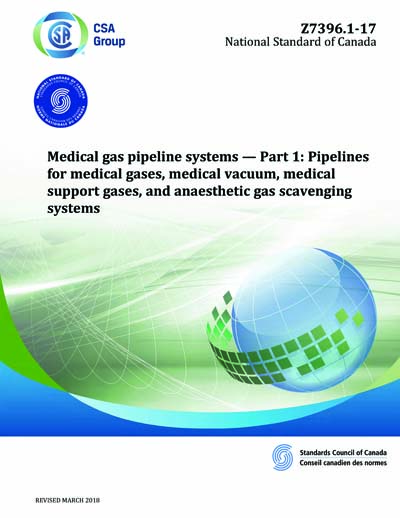Historical
CSA Z7396.1-2017
Z7396.1-17 - Medical gas pipeline systems - Part 1: Pipelines for medical gases, medical vacuum, medical support gases, and anaesthetic gas scavenging systems
Preface
This is the fourth edition of CSA Z7396.1, Medical gas pipeline systems - Part 1: Pipelines for medical gases, medical vacuum, medical support gases, and anaesthetic gas scavenging systems. It supersedes the previous editions published in 2012, 2009, and 2006. It is comparable in scope to ISO 7396-1, Medical gas pipeline systems - Part 1: Pipeline systems for compressed medical gases and vacuum and ISO 7396-2, Medical gas pipeline systems - Part 2: Anaesthetic gas scavenging disposal systems, but contains requirements to reflect Canadian practices and safety considerations. This Standard is primarily intended to address new installations and does not require the retrofitting of existing systems. Clause 11.5 covers repairs, additions, and modifications to existing pipeline systems. For existing systems, the Subcommittee recommends that health care facilities document and survey their installations to determine the adequacy of the pipeline distribution system and to properly identify components requiring emergency repairs or maintenance. This edition of CSA Z7396.1 includes comprehensive requirements and guidance for safety in medical gas pipeline systems. This edition sees expansion in requirements and guidance on a) maintenance; b) qualified person designations; c) oxygen concentrators*;- * Content referenced from CAN/CSA-Z10083 for oxygen concentrator supply systems in the 2012 edition of CSA Z7396.1 has been fully incorporated into the 2017 edition.
Scope
1.1 This Standard specifies safety requirements for pipelines for medical gases, medical vacuum, medical support gases, and anaesthetic gas scavenging systems in health care facilities, both public and private. It applies to all facilities providing health care services, regardless of type, size, location, or range of services, including, but not limited to a) acute care hospitals; b) in-patient continuing care hospitals; c) long-term care facilities; d) community-based providers; e) leased/rental suites in office buildings; and f) ambulatory and outpatient care clinics (e.g., day surgery, endoscopy clinics, dentists' offices, and doctors' offices). 1.2 This Standard is intended for use by anyone involved in the design, installation, commissioning and testing, documentation, operation, and maintenance of pipelines for medical gases, medical vacuum, medical support gases, and anaesthetic gas scavenging systems. The requirements cover a) the design of systems to ensure the continuous supply of gas or vacuum in normal condition or in single fault condition; b) the selection of materials and components; c) the non-interchangeability of equipment between different gas systems and services; d) the cleanliness of materials and components and of the completed system; e) installation procedures for supply systems and pipelines; f) the configuration of system components; g) control, monitoring, and alarm systems; h) the markings and information to be supplied by the manufacturer or installer; i) contaminant testing of pipelines; j) the final testing of each medical gas pipeline prior to its use in patient care to ensure that it contains only the specified gas; and k) maintenance and ongoing verification. 1.3 This Standard applies to pipeline systems for a) medical gases or medical gas mixtures, including- i) oxygen USP; ii) oxygen 93 USP; iii) medical air USP; iv) nitrous oxide USP; v) carbon dioxide USP; vi) helium USP; vii) oxygen USP/nitrous oxide USP mixtures; viii) helium USP/oxygen USP mixtures; and ix) other medical gases;
- i) instrument air; and ii) nitrogen NF;
Content Provider
CSA America, Inc. [csa]






